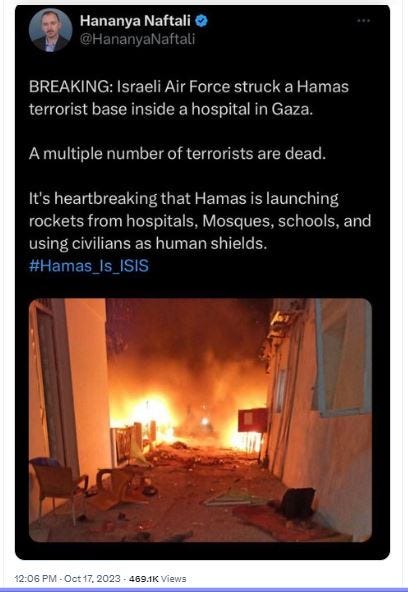The Foghorn Of War, Hospital Blast Edition
Blame Games People Play
By now you’ve probably heard about and perhaps even seen pictures from the deadly explosion at the al-Ahli Arab Hospital in Gaza City. Initially reported by Hamas, the daunting scenes of carnage that followed were blamed on an Israeli missile strike. A video posted on the Platform Formerly Known As Twitter seemed to back that up, with a loud, ominous shrieking whistle preceding a loud explosion and fireball at the possible site of the hospital, which was otherwise shrouded in darkness.
It took about an hour for the major cable news organizations to catch-up with initial reports by the AP, Aljazeera and the BBC. Most went with a “reported” or “alleged” Israeli airstrike, but, perhaps predictably, Aljazeera and other Arab-based news websites didn’t hedge their headlines. After about 45 minutes of reporting by CNN, Israeli spokesperson Mark Regev took to the air to begin challenging the narrative, saying the IDF was investigating the claim and reminding CNN and its viewers of the likelihood of “errant rockets,” which he asserted are common. He then went to the BBC and was followed on CNN by IDF spokesperson Lt. Col. Jonathan Conricus, who has become a regular presence on television screens.
As the spokespersons bounced from channel to channel they started giving real-time reports from the IDF as they made their determinations. By the third hour of coverage the IDF had wrested control of the narrative, asserting that it was indeed an errant rocket they attributed to Palestinian Islamic Jihad (notably not Hamas) and they produced video of a rocket that apparently exploded in mid-air before it fell to earth and triggered an explosion on the ground. Additionally, they promised evidence from an intercepted call between members of Hamas which indicated they knew it was an errant rocket. That was posted on the Platform Formerly Known As Twitter some time later.
By the following day, President Biden ham-handedly said the hospital explosion looked like it was “done by the other team” at the start of his unprecedented visit to Israel. He cleaned that up later with an additional confirmation of IDF claims by US intelligence, but the damage had already been done. The visceral reaction to the carnage triggered a wave of condemnation around the Arab world, and his planned meeting with Arab leaders in Jordan was scuttled before he ever got there. News outlets were forced to run headlines referring to dueling claims and accusations. The stories all prominently featured IDF denials and assertions, but because of the dearth of reporters on the ground inside Gaza, they were left trying to piece together open source information and compare it to claims and counter-claims. The Washington Post did confirm the veracity of the initial video that hit the Platform Formerly Known As Twitter (as noted above), but most major news orgs are still trying “independently confirm” the determinations by the IDF and US Intelligence. And that’s likely to take days or maybe even weeks.
Even if and when that independent confirmation comes, which right now seems entirely possible given the light-of-day evidence and the inherent stupidity of the IDF striking a hospital on the eve of a presidential visit, it is unlikely to assuage Israel’s critics. At the same time, the IDF is using both the blame laid by Hamas and the recalcitrance of the Arab world in the face of their conclusions as conclusive evidence that they all perpetrate lies about the Israeli military and its excesses. You can see that counter-offensive in the ongoing war being fought for hearts and minds right now on social media. For its part, Hamas will be loathe to concede its grasp on a narrative equally as incendiary as “forty beheaded babies,” but there are other problems that will make any ultimate confirmation unlikely to change many of the minds made-up in the first couple hours of the hospital story.
One is the IDF’s history of delaying and denying, as typified by the killing of Al Jazeera journalist Shireen Abu Akleh, which began with the IDF blaming Palestinians and, after an investigation spearheaded by critics, eventually led to an apology by the IDF for her death. Another problem is Israel’s conduct of the war thus far, which has used massive amounts of air power to level wide swathes of the besieged territory and, despite IDF protestations, had previously hit the hospital in question on “Oct. 14, according to the Gazan health ministry and video footage verified by The New York Times.” Making matters worse, an Israeli social media influencer close to Netanyahu posted a tweet in the immediate aftermath of yesterday’s attack:
The tweet was later deleted and, as Aljazeera reported, “Naftali apologised on X for sharing ‘a Reuters report’ that ‘falsely stated Israel struck the hospital’” because “‘the [Israeli army] does not bomb hospitals.’” Despite his retraction, the tweet was circulated widely around social media and became a smoking gun for anyone who wants to claim the IDF is now perpetrating a cover-up. If nothing else, it shows potential peril of relying on social media influencers to “get ahead of the story” when the story is shrouded in the fog of war.



